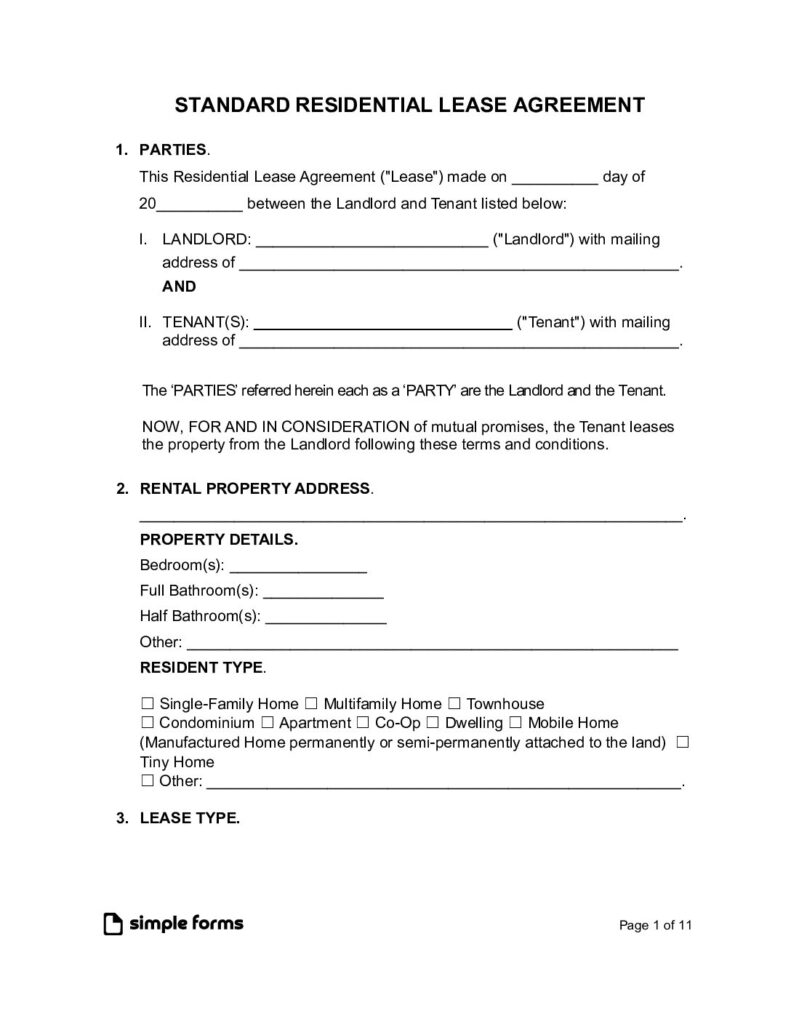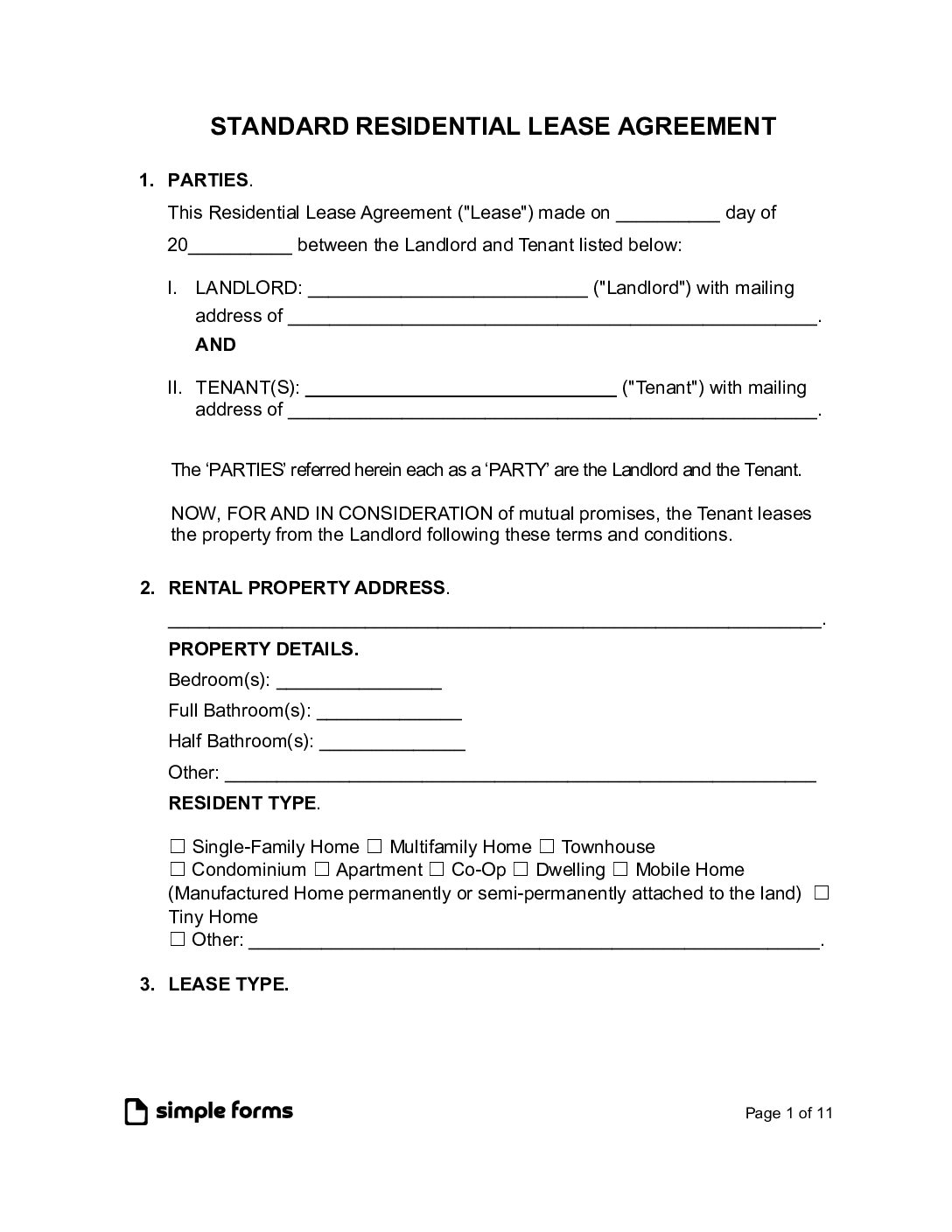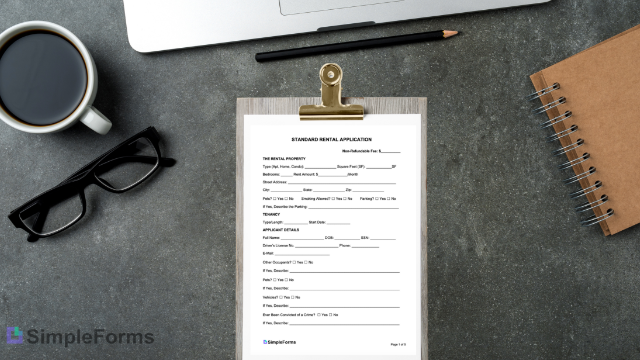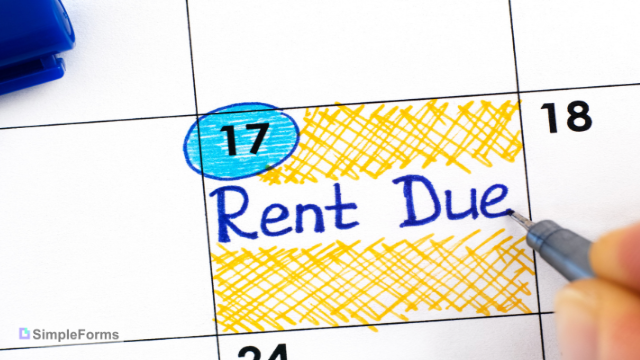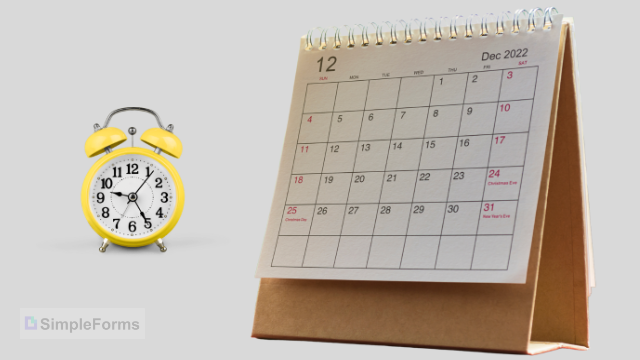Lease Agreement By State
- Alabama
- Alaska
- Arizona
- Arkansas
- California
- Colorado
- Connecticut
- Delaware
- Florida
- Georgia
- Hawaii
- Idaho
- Illinois
- Indiana
- Iowa
- Kansas
- Kentucky
- Louisiana
- Maine
- Maryland
- Massachusetts
- Michigan
- Minnesota
- Mississippi
- Missouri
- Montana
- Nebraska
- Nevada
- New Hampshire
- New Jersey
- New Mexico
- New York
- North Carolina
- North Dakota
- Ohio
- Oklahoma
- Oregon
- Pennsylvania
- Rhode Island
- South Carolina
- Texas
- Washington D.C.
How to Write a Standard Lease Agreement
Follow these steps to create a legally binding house lease agreement.
- Screen Potential Tenants with a Rental Application
- List All Parties Involved in the Transaction
- Describe the Property Address and Key Features
- Outline the Rent Terms and Due Dates
- List Landlord and Tenant Responsibilities of the Utilities and Services
- List Appliances and Furnishings Included with the Renal Property
- Set the Lease Duration and Renewal Options
- Security Deposit Requirements
- State the Smoking Policy Rules and Areas
- State Pet Policy and Pet Rules
- Attach Required Disclosure Forms
Step 1 – Screen Tenants with a Rental Application
Summary: Before writing and signing the lease, check the tenant’s employment and credit history with a Rental Application. This document collects details about the tenant’s income, job status, credit score, and references. It helps landlords make sure that the tenant can afford the rent and has a good track record.
Step 2 – List All Parties Involved in the Transaction (Landlord/Tenant)
Summary: Include the full names and contact details of the landlord and tenant(s). If a property manager is involved, their information should also be added.
Step 3 – Describe the Property Address and Key Details
Summary: List property details such as:
- Property Mailing Address
- List number of bedrooms and bathrooms
- Included unique features such as parking or a gym
Step 4 – Outline the Rent Payment Terms and Due Dates
Clearly state the following:
- Monthly rent amount
- Due date (“rent is due on the 1st of every month”)
- Payment instructions, including acceptable payment methods
- Late fees and grace periods (In New York, landlords cannot charge a late fee until after the 5th day).[2]
Step 5 – List Landlord/Tenant Responsibilities of Utilities and Services
Step 6 – List Included Appliances and Furnishings
Summary: Include a detailed list of appliances and furnishings provided with the property, such as:
- Refrigerator
- Oven
- Microwave
- Washer and dryer
- Furniture (if applicable)
Step 7 – Set the Lease Duration, Renewal Options, and Termination Rules
Summary: The most common lease is 12 months. Follow state-specific laws for leases with longer terms. Define the lease term (e.g., 6 months, 12 months) and specify renewal terms. Indicate any renewal policies or notice periods for non-renewal.
Step 8 – Security Deposit Requirements and Amount
Summary: State the amount (usually one (1) month’s rent), conditions for return, and any state-specific limits.
- The security deposit amount
- Conditions for return (e.g., cleanliness, no damages)
- State-specific limits and handling requirements
Step 9 – Smoking Policy Rules and Smoking Areas
Step 10 – State Pet Policy and Rules
Summary: Clarify if pets are allowed. Include restrictions on breeds or sizes, pet fees, or deposits, and rules. Service animals must be accommodated by federal law.[3]
Step 11 – Attach Required Disclosure Forms by Law
Summary: Attach legally required documents, such as:
- Lead-Based Paint Disclosure Form Form and EPA Pamphlet – Let tenants know if there is lead paint or other lead hazards (required for properties built before 1978).
- Asbestos Disclosure – Let tenants know if there is asbestos in the building (required for properties built before 1979). epa.gov
- Bed Bug Addendum – Explain what both the landlord and tenant should do if bedbugs are found. epa.gov
- Carbon Monoxide and Smoke Detector Addendum – Clarify if the landlord provides detectors and the tenant’s responsibility to maintain them. ncsl.org
- Commercial Lease Addendum – Make changes or additions to an existing commercial lease.
- Death in Rental Unit Disclosure – Inform tenants if someone has died in the property. realtor.com
- Flood Hazard Area Disclosure – State if the property is in a flood zone.
- Foreclosure Notice – Notify tenants of a potential foreclosure.
- Illegal Substance Contamination Disclosure – Inform tenants if the property has been contaminated by illegal substances, like meth.
- Mold Disclosure – Tell tenants if there is mold and whether the landlord will fix it.
- Notice of Abandoned Personal Property – Let tenants know if they left items behind and need to collect them before they’re thrown out.
- Pet Addendum – Outline the rules for pets on the property.
- Shared Utilities Disclosure – Explain how utilities are shared between tenants.
- Smoke-Free Addendum – Specify if smoking tobacco or marijuana is allowed on the property.
Sources
Landlord Access Laws By State
State |
Required Notice |
Statute |
| Alabama | 2 days | § 35-9A-303 |
| Alaska | 24 hours | § 34.03.140 |
| Arizona | 48 hours | § 33-1343 |
| Arkansas | N/A | N/A |
| California | 24 hours (non-emergency), 48 hours (move-out inspection) | § 1954 |
| Colorado | N/A | N/A |
| Connecticut | Reasonable notice | § 47a-16 |
| Delaware | 48 hours | Title 25 § 5509 |
| Florida | 24 hours | § 83.53 |
| Georgia | N/A | N/A |
| Hawaii | 2 days | § 521-53 |
| Idaho | N/A | N/A |
| Illinois | N/A | N/A |
| Indiana | Reasonable notice | § 32-31-5-6 |
| Iowa | 24 hours | § 562A.19 |
| Kansas | Reasonable notice | § 58-2557 |
| Kentucky | 2 days | § 383.615 |
| Louisiana | N/A | N/A |
| Maine | 24 hours | § 6025 |
| Maryland | N/A | N/A |
| Massachusetts | Reasonable notice | Sanitary Code (410.810) |
| Michigan | N/A | N/A |
| Minnesota | “Reasonable notice” (no less than 24 hours) | § 504B.211 |
| Mississippi | N/A | N/A |
| Missouri | N/A | N/A |
| Montana | 24 hours | § 70-24-312 |
| Nebraska | 24 hours | § 76-1423 |
| Nevada | 24 hours | NRS 118A.330 |
| New Hampshire | Reasonable notice | RSA 540-A:3 |
| New Jersey | 1 day | § 5:10-5.1 |
| New Mexico | 24 hours | § 47-8-24 |
| New York | N/A | N/A |
| North Carolina | N/A | N/A |
| North Dakota | Reasonable notice | § 47-16-07.3 |
| Ohio | 24 hours | § 5321.04 |
| Oklahoma | 1 day | § 41-128 |
| Oregon | 24 hours | § 90.322 |
| Pennsylvania | N/A | N/A |
| Rhode Island | 2 days | § 34-18-26 |
| South Carolina | 24 hours | § 27-40-530 |
| South Dakota | 24 hours | § 43-32-32 |
| Tennessee | 24 hours | § 66-28-403 |
| Texas | N/A | N/A |
| Utah | 24 hours | § 57-22-4 |
| Vermont | 48 hours | § 4460 |
| Virginia | 24 hours | § 55.1-1229(A) |
| Washington | 2 days (repairs), 1 day (showings) | § 59.18.150 |
| West Virginia | N/A | N/A |
| Wisconsin | Advance notice | § 704.05(2) |
| Wyoming | N/A | N/A |
State Security Deposit Laws By State
| State | Maximum Deposit | Notice Period | Sources |
|---|---|---|---|
| Alabama | 1 months’ rent | 60 days | § 8-8-15(b)§ 35-9A-201(a), § 35-9A-201(b) |
| Alaska | 2 months’ rent | 14-30 days | § 34.03.070(a), § 34.03.070(g) |
| Arizona | 1.5 months’ rent | 14 days | § 33-1321 |
| Arkansas | 2 months’ rent | 60 days | § 18-16-304, § 18-16-305 |
| California | 1 months’ rent | 21 days | § 1950.5 |
| Colorado | 2 months’ rent | 1-2 months | § 38-12-102.5, § 38-12-103 |
| Connecticut | 1-2 months’ rent | 21-15 days | § 47a-21 |
| Delaware | 1 month’s rent | 20 days | § 1301A |
| Florida | No Limit | 15-30 days | § 83.49(3)(a) |
| Georgia | 2 months rent | 30 days | § 44-7-30.1, § 44-7-34 |
| Hawaii | 1 month’s rent | 14 days | § 521-44 |
| Idaho | No limit | 21-30 days | § 6-321 |
| Illinois | No limit | 30-45 days | § 765 ILCS 710 |
| Indiana | No limit | 45 days | § 32-31-3-12 |
| Iowa | 2 months’ rent | 30 days | § 562A.12 |
| Kansas | 1 month’s rent (unfurnished), 1.5 months’ rent (furnished) | 14-30 days | § 58-2550 |
| Kentucky | No limit | 60 days | § 383.580(6) |
| Louisiana | No limit | 1 month | § 9:3251§ 6032 |
| Maine | 2 months’ rent | 21-30 days | § 6032, § 6033 |
| Maryland | 1 month’s rent | 45 days | § 8–203 |
| Massachusetts | 1 month’s rent | 30 days | Chapter 186, Section 15B |
| Michigan | 1.5 months’ rent | 30 days | § 554.602, § 554.609 |
| Minnesota | No limit | 3 weeks | § 504B.178 |
| Mississippi | No limit | 45 days | § 89-8-21 |
| Missouri | 2 months’ rent | 30 days | § 535.300 |
| Montana | No limit | 10-30 days | § 70-25-202 |
| Nebraska | 1 month’s rent (excluding pet fees) | 14 days | § 76-1416 |
| Nevada | 3 months’ rent | 30 days | NRS 118A.242 |
| New Hampshire | 1 month’s rent or $100 (whichever is greater) | 20-30 days | RSA 540-A:6, RSA 540-A:7 |
| New Jersey | 1.5 months’ rent | 30 days | § 46:8-21.2, § 46:8-21.1 |
| New Mexico | 1.5 months’ rent | 30 days | § 47-8-18 |
| New York | 1 month’s rent | 14 days | § 7-108(e) |
| North Carolina | 1.5-2 months’ rent | 30-60 days | § 42-51, § 42-52 |
| North Dakota | 1 month’s rent (excluding pet deposits) | 30 days | § 47-16-07.1 |
| Ohio | No limit | 30 days | § 5321.16 |
| Oklahoma | No limit | 45 days | § 41-115(B) |
| Oregon | No limit | 31. days | § 90.300 |
| Pennsylvania | 2 months’ rent | 30 days | § 250.511a, § 250.512 |
| South Carolina | No limit | 30 days | § 27-40-410 |
| South Dakota | 1 month’s rent | 14-45 days | § 43-32-6.1, § 43-32-24 |
| Tennessee | No limit | 30 days | § 66-28-301 |
| Texas | No limit | 30 days | § 92.103 |
| Utah | No limit | 30 days | § 57-17-3 |
| Vermont | No limit | 14-16 days | § 4461 |
| Virginia | 2 months’ rent | 45 days | § 55.1-1226(A) |
| Washington | No limit | 30 days | § 59.18.280 |
| West Virginia | No limit | 45-60 days | § 37-6A-2 |
| Wisconsin | No limit | 21 days | § 134.06 |
| Wyoming | No limit | 15-30 days | § 1-21-1208(A) |
Frequently Asked Questions
What is a lease?
What is a Residential Lease Agreement?
A Residential Lease Agreement is a contract for renting a home or apartment. It outlines the rights and responsibilities of both the landlord and the tenant. This type of agreement can be used for renting houses, apartments, condos, townhouses, and more.Other names for a Residential Lease Agreement include the following:
- Lease agreement
- Rental agreement
- Lease contract
- Apartment lease
- House rental agreement
- Tenancy agreement
- Rent-to-own lease agreement
How to Create a Residential Lease Agreement?
Who pays the security deposit?
Does a lease takeover break a lease?
What is pro rata share in a lease?
What is pro rata share in a lease?
Who is the lessor?
Who is the lessee?
Does a lease need to be notarized?
Where to get a lease agreement form?
How to terminate/cancel/break a lease?
How to spot a fake lease agreement?
What is a lease purchase agreement?
What is a car lease agreement?
How do you cancel a lease agreement?
How to Counter Sign on a Zillow Lease?
Counter sign on Zillow lease by clicking on the “Leases” section of listing in Rental Manager Account and sign after Tenants have already signed.
According to a housing study conducted in 2022, 68.2% of leases were classified as fixed-term (standard) agreements.[1]
Sample Standard Residential Lease Agreement
Download: PDF / Word (.docx)
